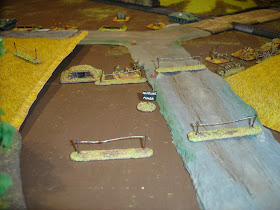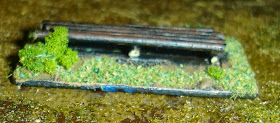With a night to reflect and more fully consult the rules the following challenges appeared:
We had not fully used the concealed troops rule to stop the Soviets from being shot up at long range by the Axis armour (minor effect in our game, but could have been significant);
I was using the wrong save roll for gun pits (didn't matter as they died anyway trying to save on a 5 or 6);
There is a correction to my initial post: the Soviet bombardment had taken out the Axis Forward Air Controller (not FAO, who was safe in his spotter plane, unable to be engaged as I couldn't find the relevant rule section - it is still a mystery). The loss of their FAC wasted the Axis purchase of air support.
On the subject of FAOs and FACs it is important to remember they only move at the end as commanders. This makes them a bit harder to "get on target". Also important is that off table artillery assets only have one action per turn.
Back to the game ...
On turn six the Axis withdrew their assault force from the central sector and all action now focused on the Soviet right. The Axis sent in their special mine clearing weapon.
This view from the Axis lines shows the Goliath advancing in the minefield. They made three or four attempts. The first one saw the Goliath blow up for no effect. I am pretty sure the Soviets with anti-tank rifles took out another attempt, but the Axis managed to get two gaps cleared before the Soviets used their on table artillery to blast the Axis engineers who were preparing the fiendish devices to pieces.
The Axis assault both gaps with flame panzers on turn 10. The left hand one is repulsed, but the one on the right succeeds and the Axis armour pours through.
However the Soviets had scheduled both and airstrike and artillery (actually Katyusha rockets) bombardment for turn 11 centred on the right hand gap.
Here we see the rockets being fired. Coming in at the same time as the airstrike in concentration on the Axis forces, the effect was deadly, probably taking out half to three quarters of the Axis armour.
We decided to end at Turn 12, which was as per the rules, although we had intended playing until we got a result. The Axis had a good breach in the Soviet lines and had another armoured force ready to roll in. It should have been easy to then roll up the Soviet centre.
The Soviet left sector was never engaged. Of course that was where the bulk of the minefields where.
Archduke Piccolo commented on the first installment of this write-up that the rule set might be considered a tad capricious. That is a fair observation. We made heavy use of initiative and opportunity fire in our game so we got at least one shot in per turn, but relying on commanders is risky. We had a few turns of inaction or severely constricted action, due to failed rolls on both side - it contributes to the fun, but can be frustrating if you are not prepared for it. If the game is playing quickly then it is not such an issue, but for us we had a lot of troops and commanders were critical so it played a major part.
That said, the most devastating thing in our game was concentrated artillery fire. Easy for the attacker to arrange. In our game it only came off for the Soviets as we allowed them to schedule attacks with a two turn delay. If we hadn't done that the game would have been very different (and a lot less fun for the Soviets).
This was only my sixth Blitzkrieg Commander game and I am still learning the rules. One thing we used in this game that we hadn't used before was the initiative phase (as we joked "we just hadn't used our initiative in previous games").
One draw back is that the scenarios are abstract although generic situations). I would say that using the rules for games based on actual battles is a challenge to get the scenario right, which is no different to most rules I have played.
What we thought might be interesting is to have a linked set of games, e.g. assault followed by counterattack.
Post Script
I just realized I failed to mention points involved. Axis was 11,200 and Soviets 7,900 however we never got all the forces engaged, never mind on the table.



























.jpg)
.jpg)











.jpg)






